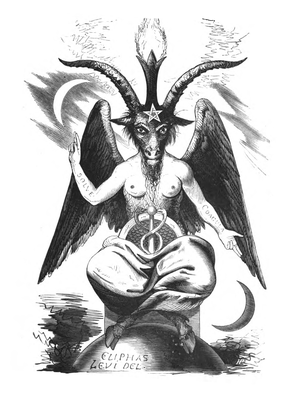Baphomet

A Baphomet is an idol or image. The word's etymology is questionable. Variously, it has been described as: an idol with a human skull, a head with two faces, a cat idol and a bearded head.
During the suppression of the Knights Templar it was claimed by the [[Inquisition]%5] that the knights used a Baphomet as part of their initiation ceremonies, and that this (among other things) sealed their heresy as an Order.
A much more recent and well known depiction shows Baphomet in the form of a goat, with a torch on his head between his horns. This image comes from Eliphas Lévi's 1854 Dogme et rituel de la haute magie (in English known as Transcendental Magic). Lévi's depiction, for all its fame, is not particularly authentic to the historical description from the Templar trials.
Baphomet, as Lévi's illustration suggests, has occasionally been understood as a synonym of Satan or a demon, a member of the hierarchy of Hell. Baphomet appears in that guise as a character in James Blish's The Day After Judgment. Jack Chick claims that he is a demon worshipped by Freemasons, a claim that apparently originated with the Taxil hoax. The head of Lévi's Baphomet inscribed in an inverted pentagram is a symbol occasionally adopted by Satanists and other followers of a Left Hand Path.
Many theories exist as to the origin of the term, including:
- From the Greek words 'Baph' and 'Metis'. The two words together would mean "Baptism of Wisdom".
- Atbash cipher for the Goddess Sophia. Dr Hugh Schonfield, one of the scholars who worked on the Dead Sea Scrolls, believed that the word "Baphomet" was created with knowledge of the Atbash cipher, which substitutes the first letter of the Hebrew alphabet for the last, the second for the second last, and so on. "Baphomet" rendered in Hebrew becomes "בפמת"; interpreted using Atbash, it becomes "שויא", which can be interpreted as the Greek word "Sophia", or wisdom.
- A slanderous deformation of the Latinised "Mahomet", a mediæval European rendering of Muhammad, the name of the Prophet of Islam.
- Idries Shah proposed that "Baphomet" may actually derive from the Arabic word Abufihamat, meaning "The Father of Understanding," and associated with Sufism.